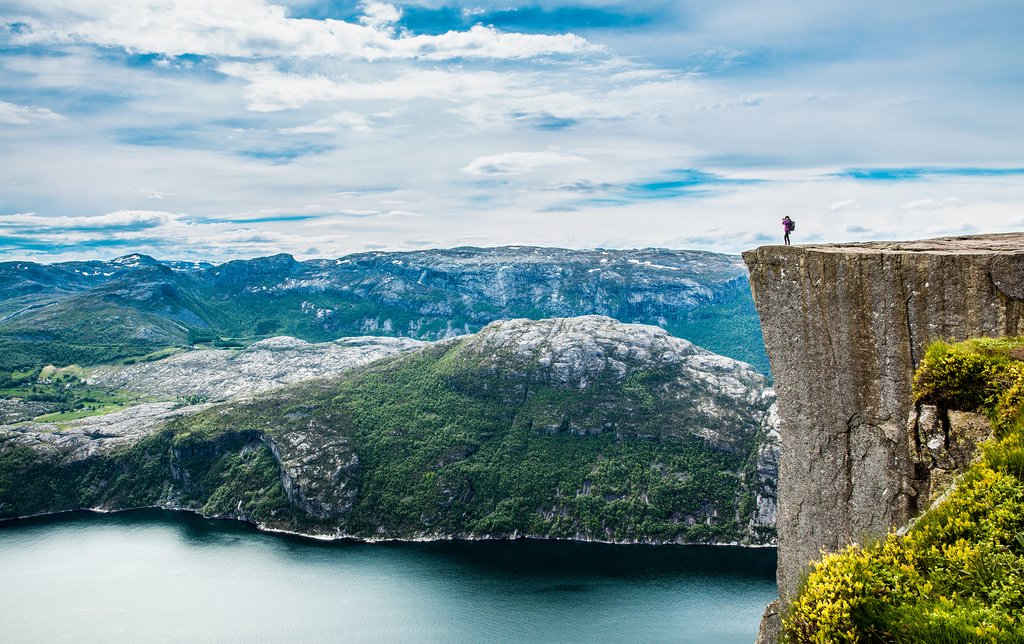Northern Lights

Norway is famous for the Northern Lights and the Midnight Sun. Unfortunately, it's not possible to see both during the same trip (unless you plan to stay for up to six months!).
The Northern Lights (also called Aurora Borealis) can only be seen on dark nights in the winter months (October to March). Since you can't predict the weather, the best way to see them is to stay in Norway for several days to increase your chances of good viewing conditions. This will provide that biggest chance to experience the magic of the northern light. The green veil — with a hint of pink and maybe purple — will suddenly surprise you as it dances over the sky.
Midnight Sun

If traveling during the winter isn't an option, consider visiting Norway for another unique natural phenomenon which takes place in northern Norway during the summer. One-third of Norway lies above the arctic circle, making it a great place to witness the Midnight Sun from May to August. The more north you travel, the longer the duration of the Midnight Sun, where the sun does not drop below the horizon throughout the entire day. It's an incredibly beautiful experience, almost unreal. You are experiencing a northern wonder of nature!
Chat with a local specialist who can help organize your trip.
Fjords

The Norwegian Fjords are majestic and a much-desired travel destination. Norway is home to more than a thousand fjords in total. Two of them — Nærøyfjorden and Geirangerfjorden — have received the UNESCO's World Heritage status.
If you're starting your Norwegian adventure in Oslo, you already have the possibility to explore a fjord, the Oslofjord. The nearby islands, just a public ferry ride from the city center, are desired leisures pots for the Oslo folk in the summer, so make sure you bring your swimming suit and picnic basket and get ready to tune in on the local vibes.
The most impressive fjords in Norway, however, are located on the west coast. Tens of thousands of years of glacial erosion have shaped the fjords into beautiful pieces of almost art-like nature. The result is breathtaking natural scenery: steep mountains on both sides with rich waterfalls diving into the blue-green water. The deepest fjords are more than 1300 meters deep. Rich in animal life and cultural traditions, the fjords in Norway are a great destination to explore the country.
Mountains

The fjords can be a great starting point for another must-see in Norway: the Norwegian mountains. Sognefjorden, Norway's deepest and longest fjord, easily connects you to the Jotunheimen National Park. Norway's highest mountain (and also the highest mountain in northern Europe), Galhøpiggen, is located here and stands 2469 meters above sea level. It's the perfect place for outdoor enthusiasts, especially if you are attracted to the mountains. There are more than 250 mountain peaks in total, each one over 2000 meters high. The famous Besseggen hike is described as an eldorado for hikers.
From Lysefjorden, you can see the famous viewpoint of Preikestolen, the Pulpit Rock. It's situated 604 meters above the fjord and is a main tourist attraction for hiking. The view from above is regarded as spectacular and is a result of pressure relief when the ice melted in the Lysefjord 10,000 years ago.
Hardangevidda National Park, Europes biggest high mountain plateau, is also not to be missed.
Southern Norway

If you plan to visit Norway in the summer months of June, July or August, southern Norway should be on your list. The coastline here is characterized by the skerries (small rock islands), a highly popular holiday destination for Norwegians. A holiday in the skerries even has its own expression: Skjærgårdsidyll (the idyll of the skerries).
Small cabins are built as close to the water as possible for the enjoyment of locals and other tourists. The island of Lyngør is still without cars and only reachable with boats and ferries. The historical aspects of southern Norway are still present in the infrastructure, where some places were mainly accessed by tall ships.
Norway's southernmost point, Lindesnes lighthouse, is a popular place to visit as it also was Norway's first lighthouse back in 1656. If you want to really top your holiday in Norway, consider booking your overnight stay in one of the lighthouses along the coastline, for instance, the Lyngør Lighthouse.
